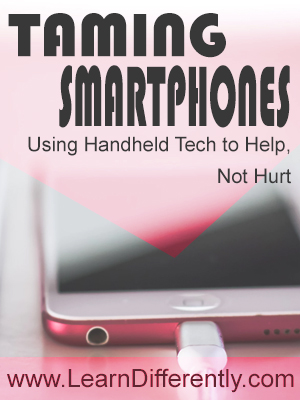Taming Smartphones: Using Handheld Tech to Help, Not Hurt

by Kathy Kuhl A smartphone is both a great tool and a great distraction. How can we harness the technology to help our struggling learners, without making life harder?
Last week in Missouri, I spoke on helping distractible students succeed. For teens, I weighed the pros and cons of carrying smartphones.
A few of the advantages of owning smartphones;

- Alarms you easily set by voice
- A cloud-based calendar
- Repeating alarms and calendar reminders help with recurring events (like karate lessons every Monday night)
- Voice recorder
- Emergency calls when driving
- GPS directions when driving
- Dozens of useful apps
Some disadvantages:
- Distractions of the Internet in your pocket always (cat videos, movie trailers, surfing the web ad infinitum)
- Social media too convenient (more on this in an upcoming post)
- Cost and fragility of the phone
- Time-wasting, addictive games and apps
- Cost of data and cellular plans
- Screen access leading you to ignore real life around you, stealing time you might otherwise spending listening, thinking, observing, creating.
So how do you decide?
- Consider now often your child loses and breaks things. Insurance such as an AppleCare plan and a sturdy cover such as the Otterbox Defender can help a smartphone last.
- One mom said she and her husband required their teen to save the money to buy a phone and to cover six months of data, as well as a plan to continue to earn enough to cover data, all before their teen could purchase a phone.
- Can you make a plan to control and limit the distractions? Will your teen sign a contract to agree to these limits?
- What software can you use to monitor their compliance? At WWDC, Apple announced the next iOS (iPhone operating system) would allow parents to limit and monitor their kids’ online use remotely from the parent’s smartphone.
- You may want to install Covenant Eyes on your Android or Apple device to block porn. This app and service sends reports to partners and parents to give you accountability, protects you from porn on all your devices, and can filter sites.
Your child doesn’t want porn? The porn industry doesn’t is eager to draw us and our kids in. They are devious in their methods of luring kids and adults into addiction.
But many households can’t afford iPhones, and even those that can may want cheaper options. I wouldn’t have bought my teens iPhones even if I’d had the money, because they were too likely to lose or break them. Can you still enjoy any of the advantages of these devices?
One Family’s Strategy, Part 1: iPods
One of the pleasures of speaking at conventions is talking with thoughtful, creative parents. Kim Hughes is one such parent. When she told me last week about her family’s strategy for enjoying the useful features of smartphones while limiting how the phones distract them, I asked her to write about it. Here’s Her reply:
My kids have had iPod Touches as young as age 7. We only put Otterbox Defender cases on them! Ipods have internet, but you can restrict it, and there is no phone service to pay for. (We also have Circle by Disney to control internet.)
They have learned to use the alarm functions to keep track of their day, whether it is reminding them to practice their instrument, or a reminder to do chores.
One child even has an alarm to remind her to eat a snack by a certain time, to prevent “sudden starvation” at bedtime! This child would always pull the starvation card. We found it wasn’t so much a stall tactic as that she was just hungry again. So to prevent the inevitable delay, we gave her a deadline by which she had to have finished eating.
Recently I saw my 15-year-old’s alarm that went off to wake him up. It had been a series of three alarms only a few minutes apart saying: “awake”, then “get up”, then “come on, man!” These alarms are very helpful to keep our 5 children on task and in routine. Though sometimes the alarms start to drive me crazy!
An added benefit is that they learn the Apple iOS, which transitions easy when they do get a phone (if it is Apple). A huge benefit for us with using Apple products is that our family members can text each other as long as the ipods have a wifi connection. So even if our children are not home, whether at a friend’s house, or at an activity, as long as they can have wifi, they can still communicate with us parents.
Also if I leave them home, I know they can still reach me. They still text me all the time!
I realize this does not work for all families, but it does work for us.
Incidentally, an older iphone with no active cell service functions as an ipod, and can be cheaper as well as be ready to activate if the child will need cell service before the device wears out.
Part 2, “Stupefying” a Smartphone
I was even more intrigued by Kelly’s second suggestion: turning a smartpone into a “dumb phone.” Making a smartphone dumb? Crazy, or genius?
I had heard about this idea the first time in 2015 from Greg McKeown, author of Essentialism: The Disciplined Pursuit of Less. McKeown’s core idea is to focus ruthlessly on the most essential tasks. Like many of us, I struggle to use my time well, so I read the book.
For leaders, the essential tasks include planning, brainstorming, creating, and looking forward. They have staff to help with some other tasks. (Some also have wives to help run their homes.)
But as parents raising kids, running households, and homeschooling, we have a lot of essentials–from diapers to dishes, from lesson plans to laundry. We must train kids in everything from washing their hands to growing in character.
Parents can’t say, “Raising men and women of godly character is my main goal, so I’ll skip diapering and cooking.” Even as an empty-nester, I have to wash dishes, laundry, floors—well, don’t check my floors today!
As a result, McKeown’s book was of limited use to me. One way McKeown did help, however, was in getting me thinking about how little things distract me. He stripped his own phone of many features to keep it from distracting him—even taking email off his phone! I removed games from my phone after reading his book.
Kim Hughes and her husband also stripped down his phone. She wrote:
Recently we discovered how to turn a smart phone to dumb phone. My husband desired a dumb phone with the perks of a smart phone. He wanted to lessen the distractibility and still be able to use his phone for work, GPS, email or other needs. This works for iPhone users.
The basics are to do three things, and require a partner:
- Go to restrictions and change (or create) the restrictions passcode to something that phone owner doesn’t know. Then turn off “Safari” (Apple’s internet browser) and turn off “installing apps.”
- Change the apple id password. (And don’t share the password with the phone owner!)
- Delete any apps you want gone and voila!
Deleting all games, Youtube, social media and Safari keeps one from being distracted! It also takes the app store icon off the phone so you can’t browse for apps.
One negative is that apps will not auto update. You will have to turn back on the “installing apps” restriction occasionally in order to update apps.
This is ideal in families where you want to restrict internet surfing and social media. You can also have one spouse do it for the other spouse’s phone, and visa versa. A parent or both can do it for the kids as well. Just remember to keep the apple ID password and restrictions passcode from the owner!
And I would add, keep those passwords safe. I use 1Password to protect my passwords.
What have you done to tame technology? Please answer in the comment section below.
Resources
- Covenant Eyes porn blocking service.
- Greg McKeown’s Essentialism: The Disciplined Pursuit of Less.
- We use 1Password to protect my passwords. Our family license covers five of us.

